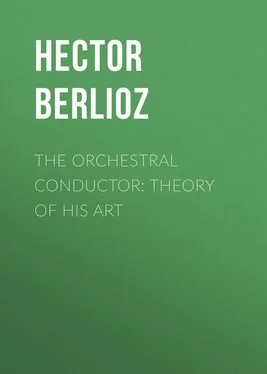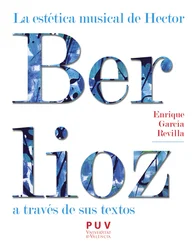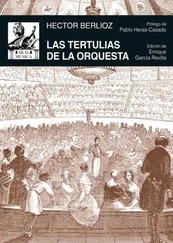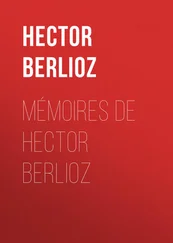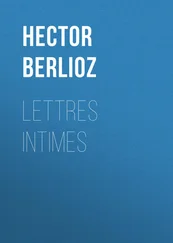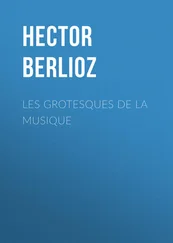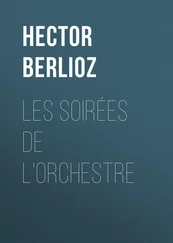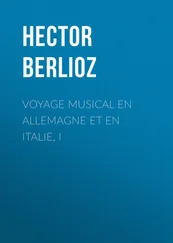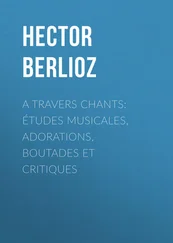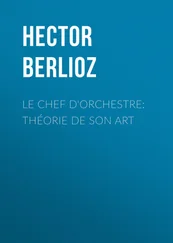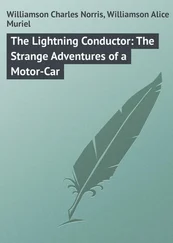Hector Berlioz - The Orchestral Conductor - Theory of His Art
Здесь есть возможность читать онлайн «Hector Berlioz - The Orchestral Conductor - Theory of His Art» — ознакомительный отрывок электронной книги совершенно бесплатно, а после прочтения отрывка купить полную версию. В некоторых случаях можно слушать аудио, скачать через торрент в формате fb2 и присутствует краткое содержание. Жанр: foreign_antique, foreign_prose, на английском языке. Описание произведения, (предисловие) а так же отзывы посетителей доступны на портале библиотеки ЛибКат.
- Название:The Orchestral Conductor: Theory of His Art
- Автор:
- Жанр:
- Год:неизвестен
- ISBN:нет данных
- Рейтинг книги:3 / 5. Голосов: 1
-
Избранное:Добавить в избранное
- Отзывы:
-
Ваша оценка:
- 60
- 1
- 2
- 3
- 4
- 5
The Orchestral Conductor: Theory of His Art: краткое содержание, описание и аннотация
Предлагаем к чтению аннотацию, описание, краткое содержание или предисловие (зависит от того, что написал сам автор книги «The Orchestral Conductor: Theory of His Art»). Если вы не нашли необходимую информацию о книге — напишите в комментариях, мы постараемся отыскать её.
The Orchestral Conductor: Theory of His Art — читать онлайн ознакомительный отрывок
Ниже представлен текст книги, разбитый по страницам. Система сохранения места последней прочитанной страницы, позволяет с удобством читать онлайн бесплатно книгу «The Orchestral Conductor: Theory of His Art», без необходимости каждый раз заново искать на чём Вы остановились. Поставьте закладку, и сможете в любой момент перейти на страницу, на которой закончили чтение.
Интервал:
Закладка:
If the conductor possess neither the author's instructions, tradition, nor metronome indications, – which frequently happens in the ancient masterpieces, written at a period when the metronome was not invented, – he has no other guide than the vague terms employed to designate the time to be taken, and his own instinct, his feeling – more or less distinguishing, more or less just – of the author's style. We are compelled to admit that these guides are too often insufficient and delusive. Of this we have proof in seeing how old operas are given in towns where the traditional mode of performance no longer exists. In ten different kinds of time, there will always be at least four taken wrongly. I once heard a chorus of Iphigenia in Tauride performed in a German theatre allegro assai, two in the bar , instead of allegro non troppo, four in the bar ; that is to say, exactly twice too fast. Examples might be multiplied of such disasters, occasioned either by the ignorance or the carelessness of conductors of orchestras; or else by the real difficulty which exists for even the best-gifted and most careful men to discover the precise meaning of the Italian terms used as indications of the time to be taken. Of course, no one can be at a loss to distinguish a Largo from a Presto. If the Presto be two in a bar, a tolerably sagacious conductor, from inspection of the passages and melodic designs contained in the piece, will be able to discern the degree of quickness intended by the author. But if the Largo be four in a bar, of simple melodic structure, and containing but few notes in each bar, what means has the hapless conductor of discovering the true time? And in how many ways might he not be deceived? The different degrees of slowness that might be assigned to the performance of such a Largo are very numerous; the individual feeling of the orchestral conductor must then become the sole authority; and, after all, it is the author's feeling, not his, which is in question. Composers therefore ought not to neglect placing metronome indications in their works; and orchestral conductors are bound to study them closely. The neglect of this study on the part of the latter, is an act of dishonesty.
I will now suppose the conductor to be perfectly well acquainted with the times of the different movements in the work of which he is about to conduct the performance or rehearsals; he wishes to impart to the musicians acting under his orders the rhythmical feeling within him, to decide the duration of each bar, and to cause the uniform observance of this duration by all the performers. Now this precision and this uniformity can only be established in the more or less numerous assemblage of band and chorus by means of certain signs made by their conductor.
These signs indicate the principle divisions, the accents of the bar, and, in many cases, the subdivisions, and the half-accents. I need hardly here explain what is meant by the “accents” (accented and unaccented parts of a bar); I am presupposing that I address musicians.
The orchestral conductor generally uses a small light stick, of about a foot in length, and rather whitish than of a dark color (it is seen better), which he holds in his right hand, to make clearly distinct his mode of marking the commencement, the interior division, and the close of each bar. The bow, employed by some violinist conductors (leaders), is less suitable than the stick. It is somewhat flexible, and this want of rigidity, together with the slight resistance it offers to the air, on account of its appendage of hair, renders its indications less precise.
The simplest of all times – two in a bar – is beaten simply.
The arm and the stick of the conductor are raised, so that his hand is on a level with his head, he marks the first beat, by dropping the point of his stick perpendicularly ( bending his wrist as much as possible; and not lowering the whole arm), and the second beat by raising the stick by a contrary gesture.

The time – one in a bar – being in reality, and particularly for the conductor, but the time of an extremely rapid two in a bar, should be beaten like the preceding. As the conductor is obliged to raise the point of his stick, after having lowered it, he necessarily divides this into two portions.

In the time – four in a bar – the first gesture, or down beat, is universally adopted for marking the first accented part, the commencement of the bar.
The second movement made by the conducting-stick, from right to left, rising, indicates the second beat (first unaccented part).  A third, transversely, from left to right, indicates the third beat (second accented part);
A third, transversely, from left to right, indicates the third beat (second accented part);  and a fourth, obliquely, from down to up, indicates the fourth beat (second unaccented part). The combination of these four gestures may be figured thus: —
and a fourth, obliquely, from down to up, indicates the fourth beat (second unaccented part). The combination of these four gestures may be figured thus: —
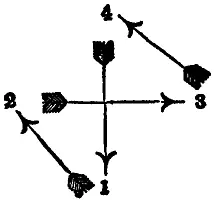
It is of importance that the conductor, in thus delivering his different directions, should not move his arm much; and consequently, not allow his stick to pass over much space; for each of these gestures should operate nearly instantaneously; or at least, take but so slight a movement as to be imperceptible. If the movement becomes perceptible, on the contrary, and multiplied by the number of times that the gesture is repeated, it ends by throwing the conductor behind in the time he is beating, and by giving to his conducting a tardiness that proves injurious. This defect, moreover, has the result of needlessly fatiguing the conductor, and of producing exaggerated evolutions, verging on the ridiculous, which attract the spectators' attention, and become very disagreeable to witness.
In the time, three in a bar, the first gesture made, from up to down, is likewise universally adopted for marking the first beat; but there are two ways of marking the second. The majority of orchestral conductors indicate it by a gesture from left to right; thus: —
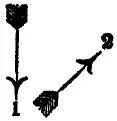
Some German Kapel-meisters do the contrary; and carry the stick from right to left; thus: —
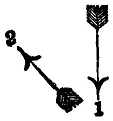
This way has the disadvantage – when the conductor turns his back to the orchestra, as in theatres – of permitting only a small number of musicians to perceive the very important indication of the second beat; the body of the conductor then hiding the movement of his arm. The other method of proceeding is preferable; since the conductor stretches his arm outwards , withdrawing it from his chest; and his stick, which he takes care to raise slightly above the level of his shoulder, remains perfectly visible to all eyes. When the conductor faces the players, it is immaterial whether he marks the second beat to the right, or to the left.
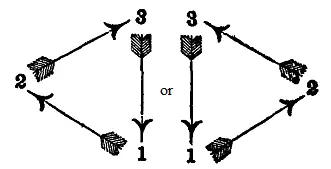
However, the third beat of the time, three in a bar, is always marked like the last of the time, four in a bar; by an oblique movement upwards.
Читать дальшеИнтервал:
Закладка:
Похожие книги на «The Orchestral Conductor: Theory of His Art»
Представляем Вашему вниманию похожие книги на «The Orchestral Conductor: Theory of His Art» списком для выбора. Мы отобрали схожую по названию и смыслу литературу в надежде предоставить читателям больше вариантов отыскать новые, интересные, ещё непрочитанные произведения.
Обсуждение, отзывы о книге «The Orchestral Conductor: Theory of His Art» и просто собственные мнения читателей. Оставьте ваши комментарии, напишите, что Вы думаете о произведении, его смысле или главных героях. Укажите что конкретно понравилось, а что нет, и почему Вы так считаете.
